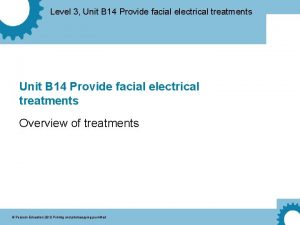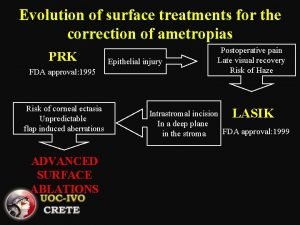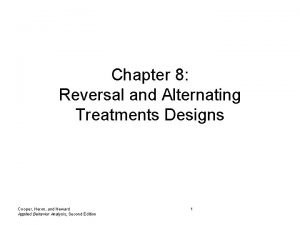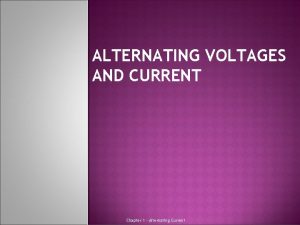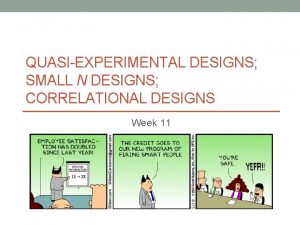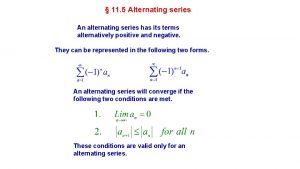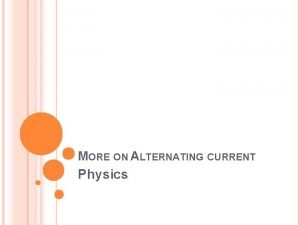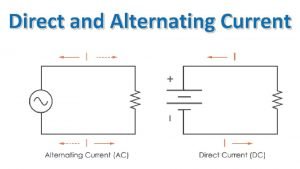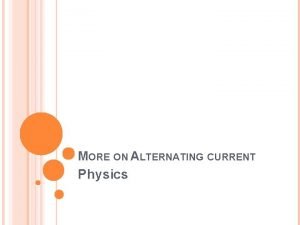Chapter 9 Overview of Alternating Treatments Designs 2019

















- Slides: 17

Chapter 9 Overview of Alternating Treatments Designs © 2019 Cengage. All rights reserved.

Learning Objectives • • 9 -1 Describe the procedures for and uses of alternating treatments design with no baseline 9 -2 Discuss how to interpret data from alternating treatments designs 9 -3 Describe the procedures for and uses of alternating treatments design with a baseline 9 -4 Describe the procedures for and uses of alternating treatments design with a baseline and a final treatment phase 9 -5 Describe the principles of prediction, verification, and replication in alternating treatments designs 9 -6 Identify the advantages and disadvantages of alternating treatments designs 9 -7 Apply your knowledge of alternating treatments designs © 2019 Cengage. All rights reserved.

9 -1 Alternating Treatments Design with No Baseline (1 of 4) • • • Basic goal: comparison of the effects of two or more independent variables (treatments) on the same behavior Requires the rapid alternation of two or more distinct treatments while their effects on a single target behavior are measured Three important points – The presentation of the treatments should be counterbalanced – The subjects should be able to discriminate between or among the treatment conditions – The dependent variables should be reversible © 2019 Cengage. All rights reserved.

9 -1 Alternating Treatments Design with No Baseline (2 of 4) • • Ingersoll, B. (2010). The differential effect of three natural language interventions on language use in children with autism. Why use this design? – • This design was used because the investigator was interested in determining the relative effectiveness of three interventions. The amount of time for the study precluded the use of other designs Limitations of the study – The lack of baseline or a no-treatment condition limits some of the conclusions that can be made about the effectiveness of the intervention © 2019 Cengage. All rights reserved.

9 -1 Alternating Treatments Design with No Baseline (3 of 4) • Limitations of the study – Three of the subjects did not respond to any of the treatment conditions – Using multiple subjects confounded the overall results because there was not a consistent pattern across all subjects © 2019 Cengage. All rights reserved.

9 -1 Alternating Treatments Design with No Baseline (4 of 4) © 2019 Cengage. All rights reserved.

9 -2 Interpreting Data from Alternating Treatments Designs • In order to assume that one treatment is more effective than the others when interpreting information from an alternating treatments design, their data paths must be separate except at the beginning of the study – Determined by calculating the percent of nonoverlapping data (PND) § § The first data point from one condition is compared to the first data point in another condition The second data point from one is then compared to the second data point of the other, etc. © 2019 Cengage. All rights reserved.

Figure 9 -5 Example of Both Ambiguous and Unambiguous Data from an Alternating Treatments Design © 2019 Cengage. All rights reserved.

9 -3 Alternating Treatments Design With a Baseline (1 of 3) Alternating Treatments Design with a Baseline • Initial baseline data should be collected before introducing the alternating treatments – Whenever possible and appropriate • The baseline data should demonstrate a stable rate of responding – Two situations where this might not be possible § § When the trend is moving in a countertherapeutic direction When the target behavior changes simply as a result of being recorded © 2019 Cengage. All rights reserved.

9 -3 Alternating Treatments Design With a Baseline (2 of 3) • • Weismer, Murray-Branch, & Miller (1993). Comparison of two methods for promoting productive vocabulary in late talkers. Purpose of the study – Determined the effectiveness of two methods of promoting productive vocabulary in young children identified as being late talkers © 2019 Cengage. All rights reserved.

9 -3 Alternating Treatments Design With a Baseline (3 of 3) © 2019 Cengage. All rights reserved.

9 -4 Alternating Treatments Design Followed by a Baseline and a Final Treatment Phase (1 of 2) • Alternating Treatments Design with a Baseline and a Final Treatment Phase – It is important to continue the most effective treatment after that determination has been made § First collect initial baseline data, then introduce alternating treatments, and then continue the study using only the most effective treatment – Methodological reason to continue implementing the most effective treatment as a final phase § Possible that the most effective treatment might lose its effectiveness once it is presented in isolation © 2019 Cengage. All rights reserved.

9 -4 Alternating Treatments Design with a Baseline and a Final Treatment Phase (2 of 2) • • Cihak, Smith, Cornett, & Coleman (2012). The use of video modeling with the picture exchange communication system to increase independent communicative initiations in preschoolers with autism and developmental delays. The design – – – An alternating treatments design with a baseline and final treatment phase The interventions were randomly presented The foods and toys were counterbalanced across students to decrease the likelihood of a student receiving the same picture more often in a specific condition © 2019 Cengage. All rights reserved.

Figure 9 -10 Carl’s Percentage of Independent Exchanges in the Alternating Treatments Design with Baseline and Final Treatment Phases © 2019 Cengage. All rights reserved.

9 -5 Prediction, Verification, and Replication • Alternating Treatment Designs addressed each of the three issues in the following way: – – – • Prediction § Each data point serves as a predictor of future behavior under the same treatment Verification § Each successive data point serves to verify previous predictions of performance under the same treatment Replication § Each successive data point provides the opportunity to replicate the differential effects produced by the treatments Recommended that at least five participants be included in a study using alternating treatments design – To better elucidate the treatment effects © 2019 Cengage. All rights reserved.

9 -7 Adaptations of the Alternating Treatments Design • • • Multielement Design – Relevant when used as part of a functional behavior assessment in which the purpose of a specific behavior is identified so that a behavioral intervention program can be developed – Used to evaluate whether a response occurs differentially across conditions, in order to identify a functional relation Simultaneous Treatments Design – The treatment conditions are presented at the same time instead of being alternated § It best approximates the conditions of the natural environment § It takes less time to determine treatment effectiveness Adapted Alternating Treatments Design – Each intervention is applied to different behaviors that are considered to be of equal response difficulty but functionally independent § Can be time consuming and problematic © 2019 Cengage. All rights reserved.

9 -8 Application Practice: Latisha – – By collecting the baseline data first, their effectiveness could be better established The final treatment phase was used to validate the effectiveness of the superior intervention by demonstrating that results were maintained when the more effective intervention was used exclusively © 2019 Cengage. All rights reserved.
 Alternating treatment
Alternating treatment Chapter 7 alternating current
Chapter 7 alternating current Treatments for acute renal failure
Treatments for acute renal failure Facial electrical treatments level 3
Facial electrical treatments level 3 Hiv treatments
Hiv treatments Diabetes treatments
Diabetes treatments Advanced surface treatments
Advanced surface treatments Insomnia treatment
Insomnia treatment Dementia treatments and interventions near patterson
Dementia treatments and interventions near patterson Chapter 10 qualitative research designs
Chapter 10 qualitative research designs Chapter 10 qualitative research designs author
Chapter 10 qualitative research designs author What are the qualities of qualitative research
What are the qualities of qualitative research Alternating method thesis
Alternating method thesis Alternative cover test
Alternative cover test Esophoria
Esophoria Alternating attention vs divided attention
Alternating attention vs divided attention Lagrange error bound vs alternating series error bound
Lagrange error bound vs alternating series error bound Krimsky and modified krimsky test
Krimsky and modified krimsky test



